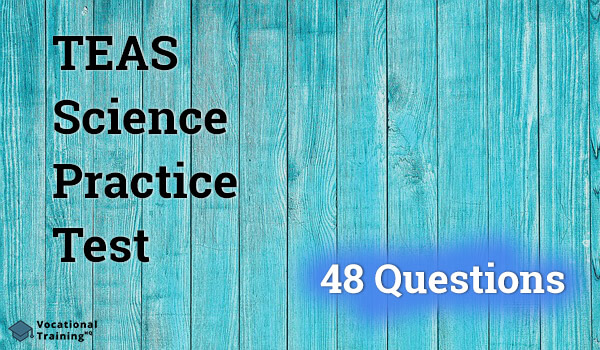The TEAS Science Practice Test is a Test of Essential Academic Skills that evaluates the specific scientific knowledge, analytics, and understanding of the topics: life science, scientific reasoning, human body science, earth science, and physical science.
This exam is developed by Assessment Technologies Institute and it is a prerequisite one of the determining factors for acceptance in numerous nursing programs.
Good luck!
TEAS Science Practice Test
Congratulations - you have completed TEAS Science Practice Test.
You scored %%SCORE%% out of %%TOTAL%%.
Your performance has been rated as %%RATING%%
Your answers are highlighted below.
Question 1 |
Please mark the correct atomic number of an unknown element that contains 45 protons and an atomic mass of 64:
19 | |
45 | |
64 | |
Impossible to determine. |
Question 1 Explanation:
The number of protons in an atom's nucleus equals the atomic number of the atom.
Question 2 |
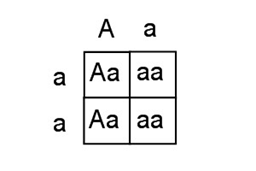 This square displays the eye color of two parents. One of them has brown eyes and has the recessive gene for green eyes (a). Please mark the correct probability regarding brown eyes of a biological child of these parents:
This square displays the eye color of two parents. One of them has brown eyes and has the recessive gene for green eyes (a). Please mark the correct probability regarding brown eyes of a biological child of these parents:50% | |
25% | |
0% | |
100% |
Question 2 Explanation:
The correct answer suggests that there is a 50 % chance that the parents will have a biological offspring with brown eyes (Aa).
Question 3 |
Please mark the correct word of the following sentence:
The functions of the liver are part of the ______ system.
endocrine | |
circulatory | |
lymphatic | |
digestive |
Question 3 Explanation:
The liver fliters blood and it is a part of the lymphatic system.
Question 4 |
Please mark the example of deductive reasoning:
Only 35% of the students have expressed their dissatisfaction with the new cantine. Therefore, the new proposal will not pass. | |
People who have a regular breakfast have fewer instances of insulin resistance. Therefore, good-quality breakfast can prevent diabetes. | |
All painters who are educated have this certificate. Therefore, any future painter who will finish university will have the certificate. | |
All interpreters are good listeners. Mary is an interpreter. Therefore, Mary is a good listener. |
Question 4 Explanation:
The correct answer is D: there is a basic correct premise which is followed by a specific logical conclusion.
Question 5 |
Please mark what you consider a cause of herniation of discs:
whiplash | |
plantar fasciitis | |
ulcer | |
hepatitis |
Question 5 Explanation:
DIsc herniation is a spinal injury that occurs when the core of a disc in the spine leaks out.
Question 6 |
Please mark the characteristic of the autonomic nervous system:
The center of intelligence. | |
A regulator of involuntary activity in the heart, lungs, stomach, and intestines. | |
A regulator of the voluntary control of body movements through skeletal muscles. | |
A part of the nervous system that consists of the brain and the spinal cord. |
Question 6 Explanation:
The autonomic nervous system regulates the functions of the digestive, respiratory and cardiovascular systems.
Question 7 |
Which two of the following are compounds of the output of glucose and oxygen during the process of photosynthesis?
Carbon dioxide and bicarbonate. | |
Carbon dioxide and water. | |
Bicarbonate and water. | |
Carbon dioxide and multiple alkaline substances. |
Question 7 Explanation:
The correct answer is carbon dioxide and water.
Question 8 |
Please consider the following diagram before you answer questions 8 and 9:
 Which of these is true regarding the frog?
Which of these is true regarding the frog?
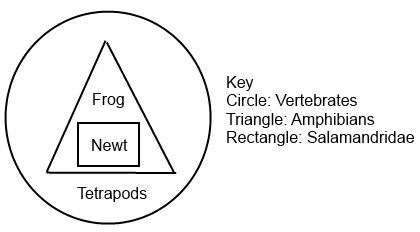 Which of these is true regarding the frog?
Which of these is true regarding the frog?A type of amphibian. | |
A non-vertebrate. | |
A member of the Salamandridae family. | |
Closer to tetrapods than to newts. |
Question 8 Explanation:
The triangle represents amphibians and the frog is a type of amphibian.
Question 9 |
 Please mark the statement that can be concluded about amphibians:
Please mark the statement that can be concluded about amphibians:All amphibians are vertebrates. Not all vertebrates are amphibians. | |
Some Salamandridae are amphibians. Not all amphibians are tetrapods. | |
Some amphibians are vertebrates. Not all amphibians are vertebrates. | |
All amphibians are Salamandridae. Nor all Salamandridae are amphibians. |
Question 9 Explanation:
All the amphibians belong to the category of vertebrates.
Question 10 |
Please mark the usefulness of the following diagram:

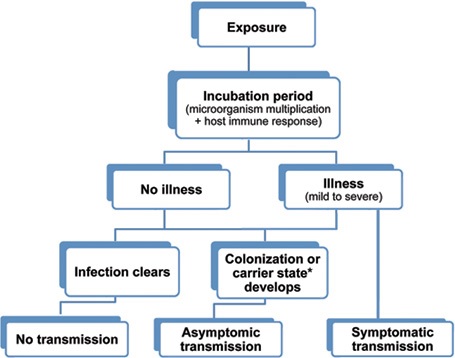
For training nurses to detect early symptoms of diseases. | |
For diagnosing infectious diseases. | |
For controlling the spread of diseases in third world countries. | |
For predicting the results of potential infections. |
Question 10 Explanation:
The diagram is used to determine if the exposure to a certain disease will lead to disease transmission.
Question 11 |
Please mark the bond between the bases of DNA which stabilizes the double helix structure:
Hydrogen | |
Ionic | |
Covalent | |
Nuclear |
Question 11 Explanation:
Hydrogen bonds are formed to stabilize the double DNA helix structure.
Question 12 |
Please mark the subatomic particles consisting into an atom's nucleus:
Electrons, protons | |
Electrons | |
Neutrons, protons | |
Electrons, protons, neutrons |
Question 12 Explanation:
The nucleus of an atom contains only neutrons and protons.
Question 13 |
Please mark the correct statement regarding trophic levels:
Secondary consumers acquire less energy content than tertiary consumers. | |
Primary consumers acquire more energy than tertiary consumers. | |
Primary consumers acquire more energy than producers. | |
Primary consumers acquire less energy than secondary consumers. |
Question 13 Explanation:
Primary consumers have more energy than both secondary and tertiary consumers.
Question 14 |
The human eye perceives a red colored automobile as the color red due to:
A red automobile will not absorb light wavelengths from colors that are not red. | |
A red automobile will absorb red light wavelengths. | |
The molecules of the automobile paint absorb green and blue light wavelengths. | |
The molecules of the automobile paint do not absorb red light wavelengths. |
Question 14 Explanation:
The wavelengths which are reflected of an object determine the color which is perceived by our eyes.
Question 15 |
Please mark the type of a variable of a light used in an experiment which tests the growth rate of plants under artificial light:
Random | |
Responding | |
Independent | |
Dependent |
Question 15 Explanation:
The so-called independent variable is a factor controlled by scientists.
Question 16 |
Please mark the organ system responsible for the metabolic regulations as well as regulations of mood and growth:
Respiratory | |
Endocrine | |
Digestive | |
Lymphatic |
Question 16 Explanation:
The endocrine system contains glands that regulate metabolism, growth and other essential bodily functions.
Question 17 |
Please mark the reason why a penny accelerates slower than an elephant as it falls to the ground:
Vector components of a penny are less complex than those of an elephant. | |
A penny is a projectile while an elephant isn't. | |
Both of them have a 9.8 m/s2 acceleration. | |
The elephant is more slowed by the effect of air resistance. |
Question 17 Explanation:
The significant amount of air resistance will make massive objects to fall free faster than the smaller ones.
Question 18 |
Please mark one of the following trains that would have the greatest momentum:
A 8600 kg train car mobbing at 195 mph | |
A 9500 kg train car moving at 200 mph | |
An 8000 kg train car moving at 215 mph | |
A 9300 kg train car moving at 190 mph
|
Question 18 Explanation:
The correct answer is B, i.e. the momentum of an object equals the mass of the object, times the velocity of the object.
Question 19 |
What is the best description for the type of correlation between the fact that an invasive species in a river provoke the decline of the population of salmon native to the river-region?
an inverse relationship | |
non-decisive relationship. | |
a direct and indirect relationship. | |
a direct relationship. |
Question 19 Explanation:
The two factors, in this case, have a strong correlation and affect each other.
Question 20 |
Please mark the effect that will be produced when a catalyst will be added to a chemical reaction:
The catalyst will increase the energy needed for the reaction to occur. | |
The catalyst will increase the time needed for the reaction to occur. | |
The catalyst will increase the rate at which the reaction will occur. | |
The catalyst will reduce the number of products in the reaction. |
Question 20 Explanation:
The correct answer is C because the addition of a catalyst will increase the rate at which the reaction will occur.
Question 21 |
Please mark the adequate body system in which the pharynx takes part:
lymphatic | |
muscular | |
respiratory | |
circulatory |
Question 21 Explanation:
The pharynx belongs to the respiratory system.
Question 22 |
Please mark the correct utterance regarding eukaryotic cells:
They contain mitochondria. | |
They contain one chromosome. | |
They do not contain lysosomes. | |
They do not contain a nucleus. |
Question 22 Explanation:
Eukaryotic cells contain mitochondria.
Question 23 |
Please mark the element which determines its specific isotope:
The number of quarks. | |
The number of electrons. | |
The number of neutrons. | |
The number of protons. |
Question 23 Explanation:
The number of neutrons defines the specific isotope of an element.
Question 24 |
Please mark what you consider FALE about RNA:
The RNA contains a sugar called ribose. | |
The RNA does not have the thymine as a base pairing. | |
The RNA is not stable in alkaline conditions. | |
The RNA contains less sugar that the sugar in the DNA. |
Question 24 Explanation:
The correct answer is D.
Question 25 |
Please mark the scenario you consider inappropriate to provide a normal distrbution:
Distribution of weekly income of Swedish families. | |
The distribution of heights in a large sample of people. | |
The percentage of toxic substances in the atmosphere will decrease the lifespan of organisms in the location.
| |
A curve with 97% of the population within the first standard deviation. |
Question 25 Explanation:
If the percentage of toxic substances increases, the living organisms will decrease.
Question 26 |
Please mark the location of the Golgi apparatus in a cell:
Cytoplasm. | |
Cell wall. | |
Mitochondria. | |
Nucleus |
Question 26 Explanation:
The Golgi apparatus is inside a cell's cytoplasm.
Question 27 |
Please mark the next-smallest rank in taxonomy after Order:
Species | |
Family | |
Genus | |
Phylum |
Question 27 Explanation:
According to taxonomy Family is the next-smallest after Order.
Question 28 |
In plants ______ contributes to the formation of a ______:
DNA, prophase | |
Telophase, cell plate | |
Cytokinesis, cell plate | |
Cleavage, cytokinesis |
Question 28 Explanation:
The cytokinesis provokes the formation of a cell plate in plants.
Question 29 |
Please mark the base that is NOT in DNA:
uracil | |
cytosine | |
guanine | |
adenine |
Question 29 Explanation:
The information in the DNA is stored in the nucleotides adenine, guanine, cytosine and thymine.
Question 30 |
Please mark the atmospheric layer which is the closest to space:
Mesosphere | |
Troposphere | |
Stratosphere | |
Thermosphere |
Question 30 Explanation:
The thermosphere is the highest atmospheric level.
Question 31 |
Please mark which of the following DOES NOT belong to the 4 basic tissue types:
connective | |
epithelial | |
nervous | |
parenchyma |
Question 31 Explanation:
The parenchyma is not one of the 4 basic types of tissue.
Question 32 |
The stomach is ________ to the small intestine.
proximal | |
lateral | |
superior | |
posterior |
Question 32 Explanation:
The stomach is superior to the small intestine, meaning "above".
Question 33 |
Please mark the number which results in the mass of an atom of 42 protons, 42 electrons, and 37 neutrons:
84 | |
121 | |
79 | |
42 |
Question 33 Explanation:
The number of protons plus the number of neutrons determines the atomic mass of the atom.
Question 34 |
Please mark the most adequate damage that is likely to have happened to a patient who has suffered head trauma and is not able to recognize people he met after the injury but can recognize people he met before that.
Pituitary Gland. | |
Hippocampus. | |
Medulla Oblongata | |
Corpus Callosum |
Question 34 Explanation:
The hippocampus storage's a person's memory.
Question 35 |
Please mark the process illustrated in the following diagram:

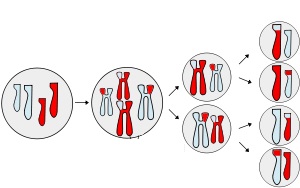
Codification | |
Replication | |
Mitosis | |
Meiosis |
Question 35 Explanation:
The correct answer if the process meiosis.
Question 36 |
Please mark one of the following bonds that is NOT chemical:
Polar | |
Covalent | |
Ionic | |
Magnetic |
Question 36 Explanation:
The mechanical bond is not a chemical one.
Question 37 |
Please mark the adequate result regarding the mass and density of a fixed size ballon when the amount of hydrogen is doubled:
The mass and density don't decrease. | |
The mass increases while the density decreases. | |
The mass decreases as well as the density. | |
The mass and the density increase. |
Question 37 Explanation:
The mass of air increases as well as its density.
Question 38 |
How much Na Cl is dissolved in a 200 mL solution of sodium chloride( 60%)?
40 g | |
80 g | |
120 g | |
50 g |
Question 38 Explanation:
A 200 mL of a 60% NaCl solution, equals 120 g of NaCl dissolved in the solution.
Question 39 |
How many molecules of carbon dioxide are needed for the balance of the following reaction?
4C6H12O6 + 24O2 → _CO2 + 24H2O + Energy
16 | |
8 | |
24 | |
4 |
Question 39 Explanation:
The number of reactants (24) must be equal to the number of carbons (24).
Question 40 |
What is the probability of life of a male methuselah 75 days after it has been exposed to pesticides? Look at the graph and answer:

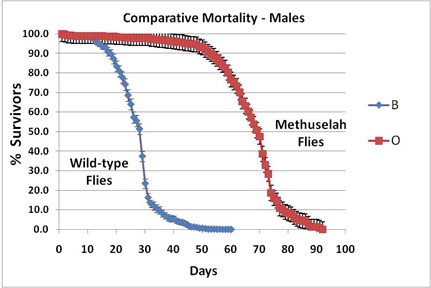
1/2 | |
1/4 | |
1/5 | |
1/3 |
Question 40 Explanation:
The correct answer regarding the methuselah's survival is 1/5.
Question 41 |
Please mark the proper relationship between these variables X= time, Y= energy, Z= power:
Z = X/Y | |
XZ = 2Y | |
Z = Y/X | |
2XY = Z |
Question 41 Explanation:
Power equals energy divided by time.
Question 42 |
Please mark the type of correlation between price and quality:
None. | |
Strong direct. | |
Weak direct. | |
Strong indirect. |
Question 42 Explanation:
The price is likely to increase as the quality increases.
Question 43 |
Mitosis produces the following cells:
4 haploid. | |
2 haploid. | |
1 diploid. | |
2 diploid |
Question 43 Explanation:
Mitosis produces 2 diploid, so-called daughter cells.
Question 44 |
Inchworms, cheetas and a rainbow trout belong to the same:
Class | |
Kingdom | |
Phylum | |
Order |
Question 44 Explanation:
The three animals belong to the same kingdom of Animalia.
Question 45 |
Which hormone will cause a decrease in water retention?
ADH | |
ANP | |
Renin | |
Aldosterone |
Question 45 Explanation:
The ANP is a hormone that contributes to the increase of excretion of water.
Question 46 |
Oxygenated blood flows out of:
The heart's right ventricle. | |
The heart's left ventricle. | |
The heart's right atrium. | |
The heart's left atrium. |
Question 46 Explanation:
The oxygenated blood flows out of the left ventricle.
Question 47 |
The hypothalamus secretes these hormones:
Oxytocin | |
Calcitonin | |
Dopamine | |
Melatonin |
Question 47 Explanation:
The dopamine is a neurotransmitter secreted from the hypothalamus.
Question 48 |
Please mark what is NOT portrayed in the following diagrams:

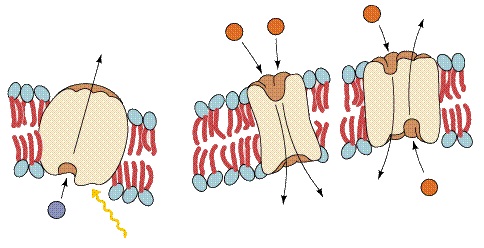
Ion Channel | |
Facilitated transport | |
Active transport | |
Antiporter |
Question 48 Explanation:
The Ion Channel does not use ATP and therefore it is not active transport.
Once you are finished, click the button below. Any items you have not completed will be marked incorrect.
There are 48 questions to complete.
Popular Programs
Featured Online Programs
Learn at home, at your own pace.
Electrician
Request InfoHVAC Tech
Request InfoAuto Mechanic
Request InfoPhlebotomy Technician
Request InfoMedical Assistant
Request InfoMedical Billing and Coding
Request InfoSee More Trades
Request Info